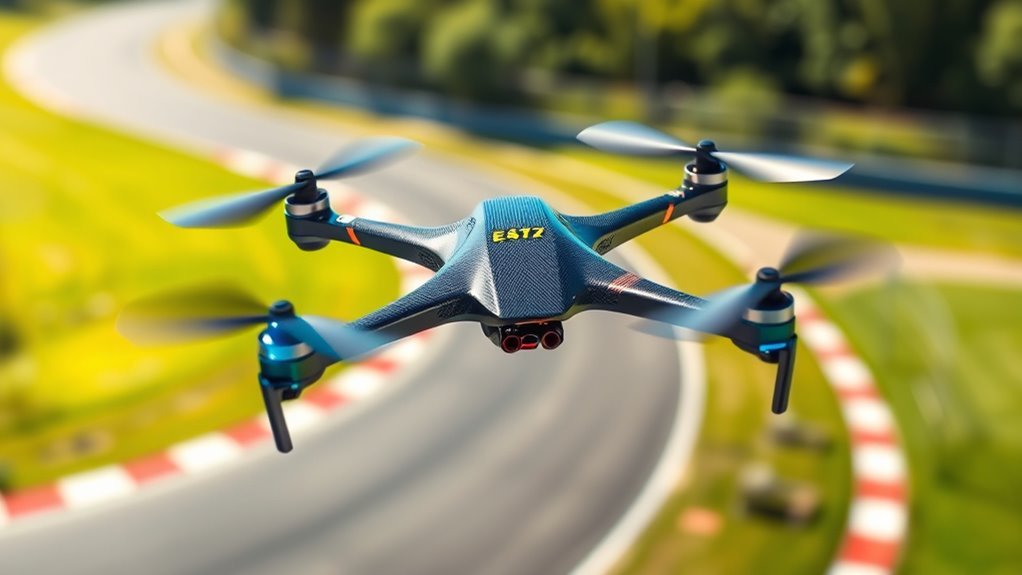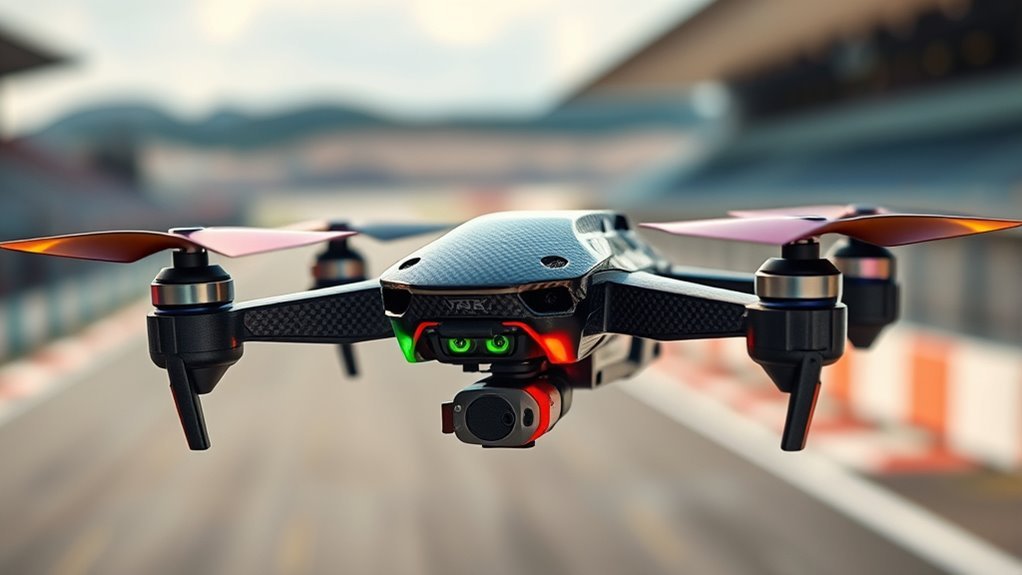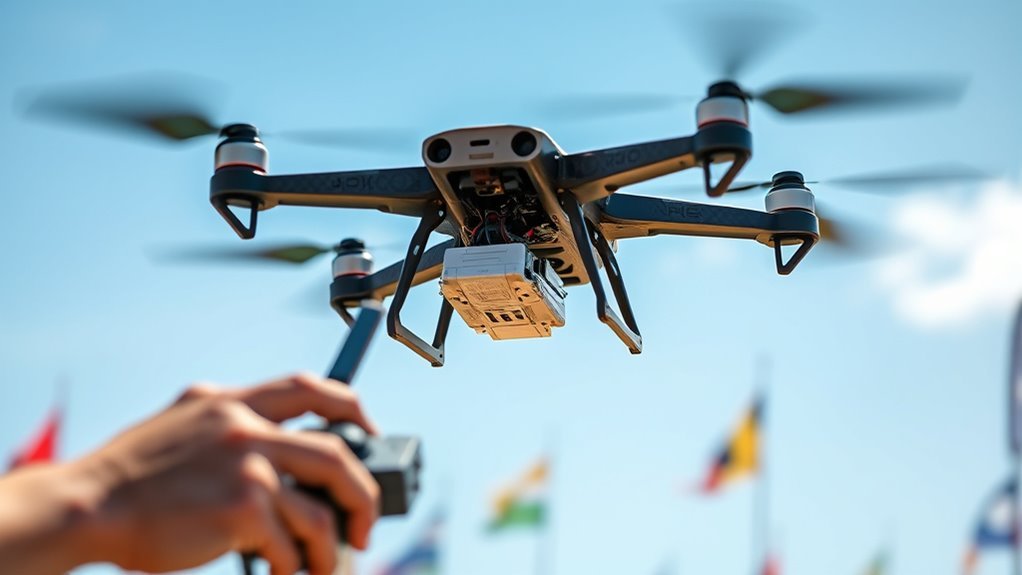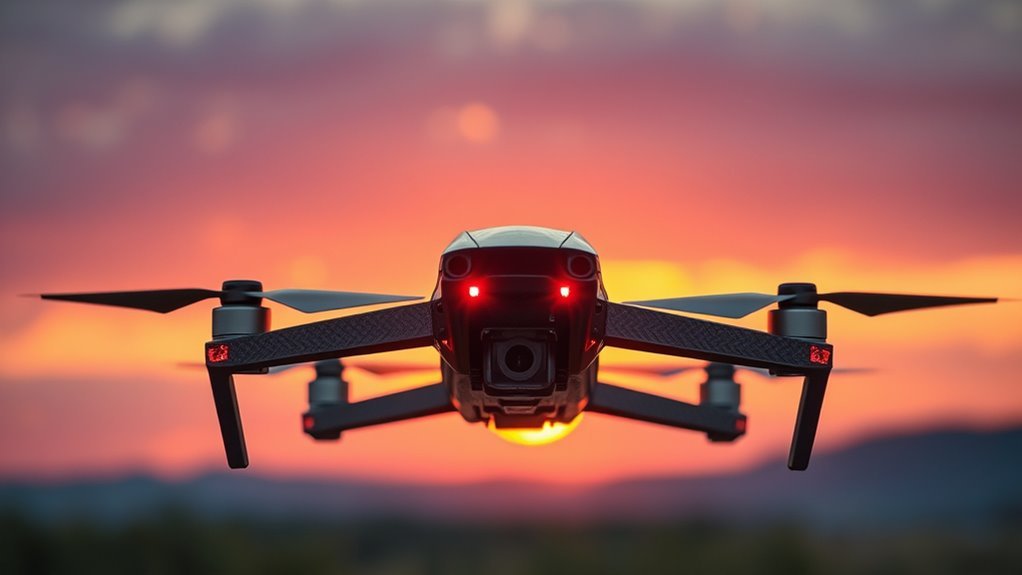Fast race drones achieve remarkable speeds through optimized aerodynamics, powerful motors, and efficient battery technology. You’ll find that frame design and materials play a critical role in weight distribution and maneuverability. Propeller selection further influences thrust and control, while FPV technology enhances pilot awareness. By mastering tuning techniques and adapting to customization, your performance can reach new heights. Discover how these components work together to elevate your racing experience and push the boundaries of speed.
Understanding Drone Aerodynamics

As you explore the world of fast race drones, understanding aerodynamics becomes essential, since the performance and stability of these machines hinge on their ability to navigate air efficiently. Effective lift generation is critical; it allows your drone to ascend rapidly and maintain altitude during races. This involves optimizing wing designs and propeller angles to create maximum airflow beneath the drone. Simultaneously, drag reduction is fundamental for minimizing resistance, enabling quicker speeds and improved maneuverability. Streamlined shapes and careful weight distribution can greatly enhance aerodynamic efficiency. By mastering these principles, you’ll reveal the potential for exhilarating flight experiences, allowing you to push the boundaries of speed and control. Embracing these aerodynamic concepts opens up a new level of freedom in racing.
The Importance of Motor Power

When selecting motors for your racing drone, the specifications play a critical role in performance. You’ll need to evaluate the thrust-to-weight ratio, as it directly impacts acceleration and maneuverability. A well-balanced motor system can enhance your drone’s agility and speed, making it essential for competitive racing.
Motor Specifications Matter
The heart of any fast race drone lies in its motor specifications, which directly influence performance and agility. Understanding motor types and their efficiency can greatly enhance your racing experience. Here’s what you should focus on:
- KV Rating: Higher KV ratings mean faster spins, but consider balance.
- Motor Size: Larger motors typically provide more power but add weight.
- Windings: Fewer windings increase speed; more windings boost torque.
- Material Quality: Lightweight, durable materials improve efficiency and longevity.
- Cooling Mechanisms: Effective cooling allows for sustained performance during intense races.
Thrust-to-Weight Ratio
In the domain of fast race drones, the thrust-to-weight ratio serves as a critical determinant of overall performance. This ratio indicates how much thrust your drone’s motors generate relative to its weight. To achieve peak speed and agility, you’ll need to employ thrust optimization techniques, such as selecting high-efficiency motors and fine-tuning propeller sizes. Additionally, weight reduction strategies play an essential role; utilizing lightweight materials can greatly enhance your drone’s maneuverability. Striking the right balance between thrust and weight not only improves acceleration but also guarantees stability during high-speed maneuvers. By focusing on these aspects, you can release the full potential of your race drone, allowing you to experience the exhilarating freedom that comes with high-performance flying.
Battery Technology and Efficiency

As advancements in battery technology continue to reshape the landscape of fast race drones, understanding the efficiency and energy density of these power sources becomes vital. Choosing the right battery chemistry can dramatically impact performance. Here are key factors to evaluate for ideal battery performance:
- Energy Density: Higher energy density means longer flight times without adding weight.
- Charge Cycles: Durability affects how many times you can recharge before performance declines.
- Weight: Lighter batteries enhance thrust-to-weight ratios, significant for speed.
- Discharge Rate: Higher discharge rates improve power delivery during intense maneuvers.
- Temperature Stability: Batteries should perform efficiently across varied temperatures to maintain reliability.
Frame Design and Materials
Choosing the right frame design and materials is essential for optimizing the performance of fast race drones. You need to evaluate frame geometry, as it greatly impacts maneuverability and speed. A well-designed frame should offer a balanced weight distribution, allowing for agile turns and stability during high-speed flights. Materials like carbon fiber or lightweight plastics minimize weight while maintaining strength, fundamental for durability in competitive environments. Additionally, a lower center of gravity enhances control, which is critical for quick direction changes. By honing in on these aspects, you can maximize your drone’s capabilities, giving you the freedom to push your racing limits. Ultimately, the right frame can make the difference between winning and losing in the fast-paced world of drone racing. Furthermore, using durable materials can significantly increase the longevity and performance of your drone in challenging racing conditions.
Propeller Selection and Optimization
When selecting propellers for your race drone, the size plays an essential role in overall performance and maneuverability. You’ll also need to take into account how blade shape can impact thrust and efficiency, affecting your drone’s speed and agility. Finally, the material you choose will influence durability, weight, and responsiveness, all vital factors in competitive racing.
Propeller Size Importance
The propeller size plays an essential role in the overall performance of race drones, influencing both speed and maneuverability. Selecting the right size is imperative for optimizing propeller efficiency and managing propeller weight, which can greatly impact your drone’s agility. Here’s what you should consider:
- Larger propellers can increase thrust but may reduce RPM.
- Smaller propellers provide higher RPM but can limit thrust.
- Balance between size and weight affects flight dynamics.
- Efficiency varies with size, impacting battery life and flight time.
- Ideal size depends on your drone’s motor capabilities and intended racing style.
Blade Shape Effects
While propeller size greatly influences performance, blade shape also plays an essential role in optimizing race drone efficiency. The curvature impact of the blades directly affects the aerodynamic efficiency, dictating how well your drone cuts through the air. A more aggressive blade design can enhance lift and thrust, but it might also create drag if not balanced properly. You’ll want to experiment with varying pitch angles and blade widths to find the sweet spot that maximizes speed without sacrificing control. Remember, a well-optimized blade shape reduces turbulence, allowing for smoother flight paths and quicker response times. Ultimately, selecting the right blade shape is vital for achieving the ultimate freedom in race drone performance.
Material and Durability
Optimizing propeller performance goes beyond just blade shape; material selection greatly impacts durability and efficiency in high-speed racing environments. Choosing the right materials not only enhances performance but also guarantees your drone withstands the rigors of racing. Here are key considerations for propeller material and durability:
- Carbon fiber offers superior strength-to-weight ratio, allowing for weight reduction.
- Impact resistance is essential for withstanding collisions and rough landings.
- Weather resistance guarantees performance remains stable in varying conditions.
- Structural integrity prevents deformation at high speeds, maintaining peak aerodynamic efficiency.
- Advanced manufacturing techniques can enhance the precision and consistency of propeller production.
Flight Controllers and Software
As you immerse yourself in the world of fast race drones, understanding flight controllers and software becomes essential for optimizing performance and responsiveness. Flight controllers serve as the brain of your drone, processing data from sensors to execute flight algorithms that determine how your drone maneuvers. Sophisticated software optimization is vital, allowing fine-tuning of settings like PID values for enhanced stability and agility. By selecting an advanced flight controller, you gain access to customizable features that enable you to tweak response rates and control profiles according to your racing style. The right combination of flight algorithms and software not only boosts speed but also enhances your control, giving you the freedom to push your drone to its limits in competitive environments. Incorporating advanced AI integration can further streamline the optimization process, allowing for rapid adjustments based on real-time performance data.
The Role of FPV (First Person View)
FPV technology transforms your racing experience by providing an immersive flight perspective that closely mimics being in the cockpit. This enhanced viewpoint greatly improves your control over the drone, allowing for more precise maneuvers. Additionally, real-time visual feedback guarantees you can react instantly to changing conditions, which is essential in competitive racing scenarios.
Immersive Flight Experience
How does the immersive flight experience transform your perception of drone racing? When you strap on FPV goggles, you’re not just watching a race; you’re part of it. This virtual reality setup delivers immersive sensations that heighten your awareness and engagement, redefining what it means to pilot a drone.
Consider these aspects of your experience:
- Heightened spatial awareness: You gauge distances and speeds more accurately.
- Enhanced adrenaline rush: The thrill of racing feels palpable.
- Intuitive control: You react instinctively to obstacles and challenges.
- Real-time decision-making: You learn to adapt quickly to changing environments.
- Community connection: You share the excitement with fellow racers, forging bonds through this shared experience.
This transformation elevates the art of racing to new heights.
Enhanced Pilot Control
One critical advantage of using FPV technology in drone racing is the enhanced pilot control it provides. With FPV, you gain immediate pilot feedback, allowing you to react to changes in real-time. This feedback loop is essential for optimizing your control responsiveness, making your maneuvers more precise. When you’re immersed in the cockpit view, your body intuitively adjusts to the drone’s movements, creating a seamless connection. As you navigate through tight turns and obstacles, the enhanced control enables you to push your limits, achieving speeds and agility that would be difficult with standard control methods. Ultimately, FPV not only elevates your racing experience but also grants you the freedom to master your drone’s capabilities like never before.
Real-Time Visual Feedback
While piloting a drone at high speeds, real-time visual feedback plays a pivotal role in guaranteeing ideal performance and decision-making. The effectiveness of FPV (First Person View) systems hinges on several critical factors:
- Real-time analytics provide instant data on speed, altitude, and battery life.
- Visual latency impacts responsiveness; lower latency guarantees smoother control.
- High-resolution video feeds enhance situational awareness, allowing for precise navigation.
- Robust transmission systems minimize signal loss, maintaining clarity.
- Adjustable camera angles enable pilots to optimize their view for specific racing conditions.
Pilot Skill and Techniques
Mastering the art of piloting race drones requires a combination of technical skill and strategic thinking. To excel, you must develop race strategies that enhance your performance while maintaining pilot focus throughout the course. Here’s a breakdown of essential techniques:
| Technique | Description | Benefit |
|---|---|---|
| Precision Control | Fine-tuning throttle and yaw | Enhances maneuverability |
| Line of Sight | Keeping the drone in view | Improves reaction time |
| Mental Mapping | Visualizing the race course | Aids in strategic decision-making |
| Consistent Practice | Regular flying sessions | Builds muscle memory |
| Adaptive Thinking | Adjusting to changing conditions | Increases overall responsiveness |
These skills sharpen your abilities, giving you the freedom to navigate complex courses with confidence and speed. Additionally, understanding signal attenuation can help you optimize your drone’s performance during races by avoiding obstacles that may disrupt communication. It’s also crucial to maintain visual line of sight to ensure safety and effective navigation throughout the race.
Tuning and Customization
Tuning and customization of race drones play an essential role in optimizing performance and achieving competitive edge. To elevate your drone’s capabilities, explore various tuning techniques and customization options that suit your racing style. Here’s what you can focus on:
Tuning and customizing race drones is crucial for enhancing performance and gaining a competitive advantage.
- PID Tuning: Fine-tune your drone’s flight controller for precision handling.
- Propeller Selection: Choose the right props to enhance speed and agility.
- Battery Optimization: Use high-discharge batteries to improve power delivery.
- Weight Reduction: Minimize drone weight for improved acceleration and maneuverability.
- Firmware Updates: Keep your flight controller updated for the latest performance enhancements. Additionally, integrating intelligent flight modes can provide enhanced control and adaptability during races.
The Future of Drone Racing Technology
As drone racing continues to gain popularity, advancements in technology are set to revolutionize the way competitors engage in this high-speed sport. Future innovations, such as AI-driven flight systems and enhanced battery efficiency, promise to push the limits of speed and agility. These technologies will allow you to achieve a competitive edge by optimizing your drone’s performance in real-time, adapting to various racing conditions. Additionally, the integration of augmented reality could transform the pilot’s experience, providing critical data overlays and immersive environments. As these advancements unfold, you’ll find that the race isn’t just about piloting skill but also about leveraging cutting-edge tech to outmaneuver your opponents, ultimately redefining what it means to be a champion in drone racing. The use of advanced navigation systems will also play a crucial role in ensuring precision and control during high-speed maneuvers. Moreover, improved battery efficiency will enhance operational flexibility, allowing pilots to maintain peak performance throughout their races.
Frequently Asked Questions
What Are the Best Brands for Racing Drones?
When considering the best brands for racing drones, you can’t overlook DJI Innovations for reliability, Fat Shark for immersive FPV experiences, ImmersionRC for performance, and Eachine Racing for affordability and innovation. Each offers unique advantages.
How Much Does a Competitive Racing Drone Cost?
A competitive racing drone typically costs between $300 to $1,500, depending on its features. You’ll find that competitive pricing often reflects advanced technology, durability, and customization options essential for achieving peak performance in racing environments.
Can I Use a Regular Drone for Racing?
You can use a regular drone for racing, but it won’t compete. Racing modifications improve drone specifications, enhancing speed and agility. Consider upgrading components for peak performance if you seek true racing excitement and freedom.
What Safety Gear Do Drone Pilots Need?
For drone safety, you’ll need goggles for enhanced focus, a helmet for head protection, and gloves to guarantee grip. Pilot training often emphasizes these essentials, helping you navigate challenges while maximizing your flying freedom.
Are There Specific Racing Leagues or Events to Join?
“Birds of a feather flock together.” If you’re enthusiastic for event participation, consider joining established racing leagues like the MultiGP or DRL. These platforms offer competitive opportunities, fostering skills and connections within the exhilarating drone racing community.

